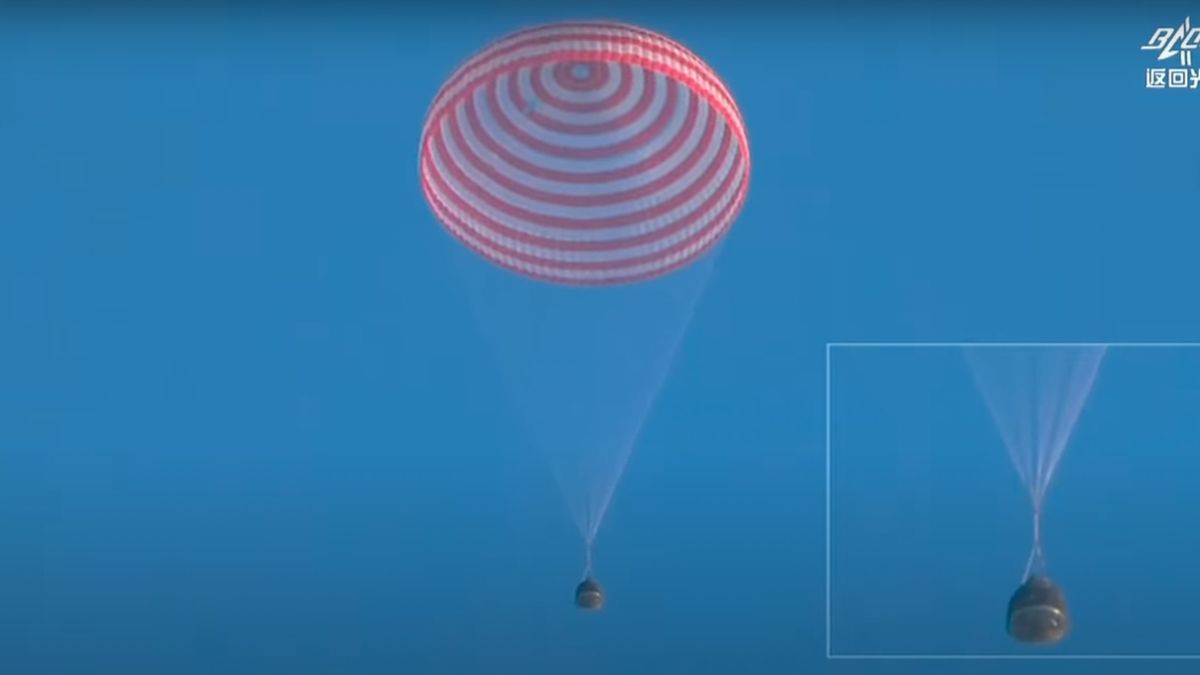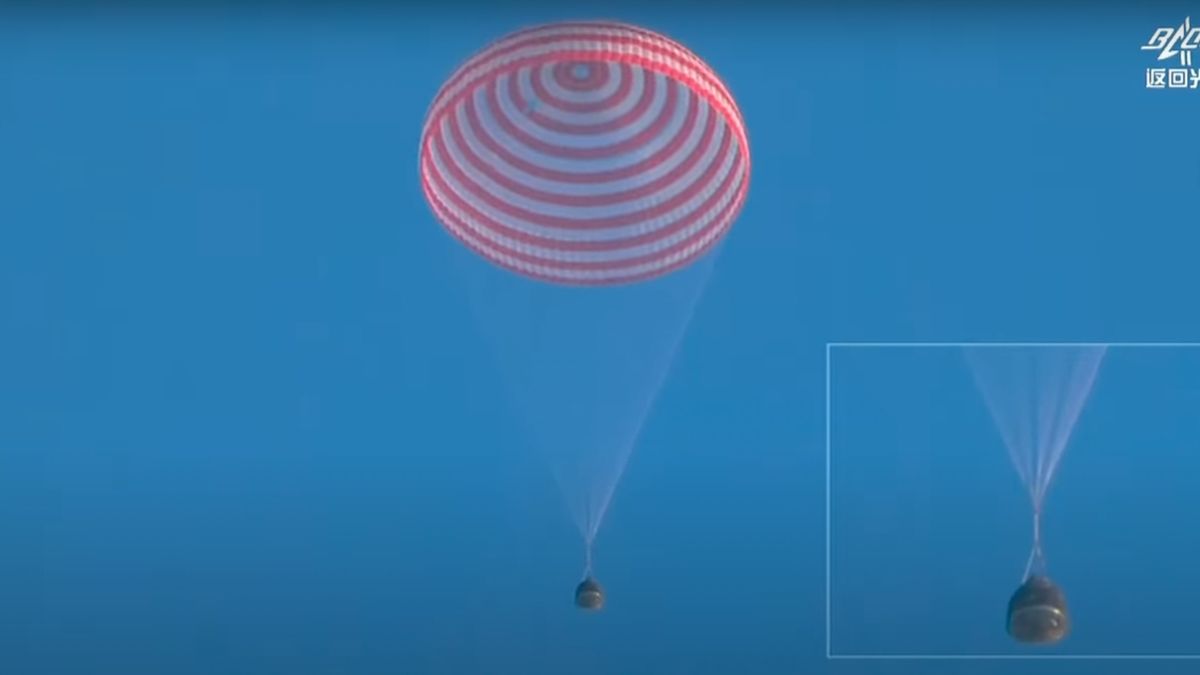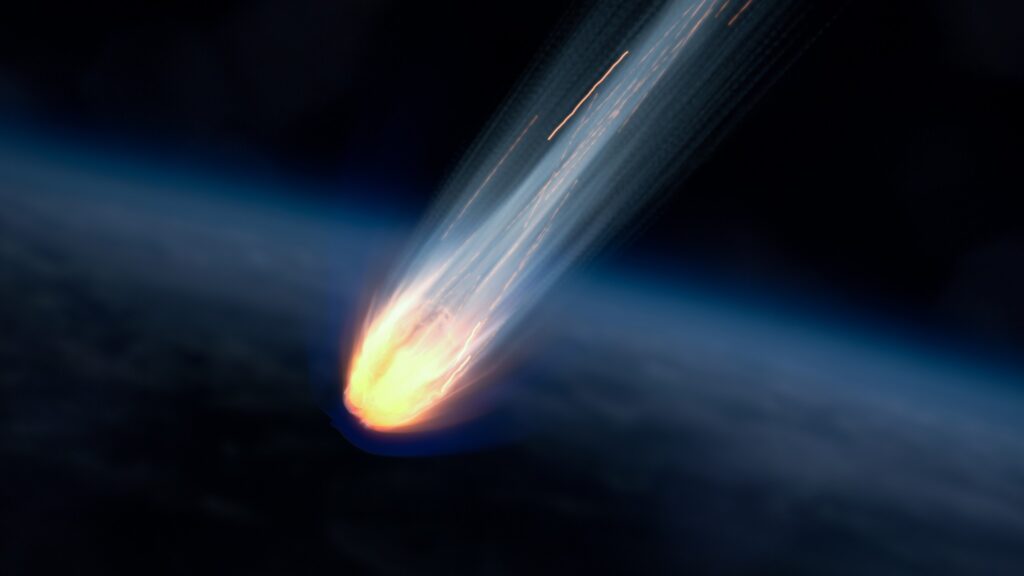
China’s Shenzhou 16 astronauts landed safely on Earth this week despite an apparent hole appearing in their return capsule’s parachute.
China Central Television (CCTV) aired video of the descent of Shenzhou 16 on Monday (Oct. 30) as the crewed spacecraft returned to Earth following five months in orbit docked with the Tiangong space station. In some of the footage, a patch of blue sky can be seen through the red-and-white-banded parachute.
Inside the capsule were Shenzhou 16 mission commander Jing Haipeng and crewmates Zhu Yangzhu and Gui Haichao — the latter pair returning to Earth after their first mission to space.
Related: China’s Shenzhou 16 astronauts land safely after 5 months aboard Tiangong space station (video)
Such a sizable hole, which was visible before a white cloud of vented propellant left the Shenzhou capsule, has not been reported during earlier missions. It did not, however, seem to affect operations.
The capsule touched down safely at the Dongfeng landing site in the Gobi Desert in Inner Mongolia at 8:11 p.m. EDT on Oct. 30 (0011 GMT and 08:11 a.m. Beijing time on Oct. 31). When it did land, however, the capsule appears to have tumbled a couple of times before being enveloped in a cloud of sand kicked up by the impact, which Shenzhou capsules soften by firing thrusters.
Jing was in high spirits after the landing, CCTV reported. “I am very much excited at this moment. We’ve finally come back home and returned to the embrace of our motherland. We have successfully completed the five-month mission,” he said.
Even if the 12,920-square-foot (1,200 square meters) parachute had failed, the crew would still have had another opportunity to slow their descent.
Shenzhou spacecraft carry a backup parachute, should the main chute fail. This would deploy automatically if the reentry capsule descended too quickly from an altitude of 6 kilometers to 5 kilometers (3.7 to 3.1 miles), Shao Limin, deputy technological manager of crewed spacecraft systems at the China Academy of Space Technology (CAST), said this past June while discussing the Shenzhou 15 mission. China’s space authorities have so far not announced an incident during Shenzhou 16’s descent.
Parachutes are not generally thought of as the most cutting-edge of technology when considering the intricacies of space travel, but they present complex challenges. Failure can be fatal, as occurred with the Soviet Union’s Soyuz 1 mission in 1967, which led to the death of cosmonaut Vladimir Komarov.
One of three parachutes to slow the descent of Apollo 15 in August 1971 failed, while SpaceX also suffered a parachute failure during testing for its Crew Dragon capsule in 2019.
RELATED STORIES:
Brian Harvey, a noted space writer and historian, told Space.com via email that there has been a previous incident involving Shenzhou parachutes. According to Harvey, some reports at the time stated that, during Shenzhou 2 — an uncrewed test flight conducted in January 2001, as China built toward human spaceflight capabilities — the cabin was damaged at the final stage of landing because one of the parachute cords broke free.
Harvey said that, after a delay, Chinese officials stopped denying that there had been a hard landing, which resulted from a broken parachute connection.
Parachute design and deployment are subjected to extensive testing and quality assurance. If a hole is found in the Shenzhou 16 parachute, China’s human spaceflight agency will likely swiftly investigate, especially with the new Shenzhou 17 crew already aboard Tiangong and set to return in six months’ time.
China is also developing a next-generation crewed spacecraft that’s larger and will be partially reusable. That new spacecraft descends to Earth with three parachutes instead of one large parachute, as Shenzhou and Soyuz craft currently do.



